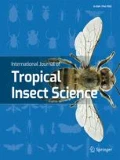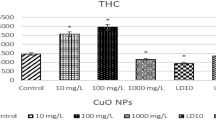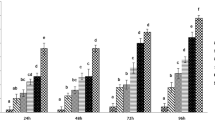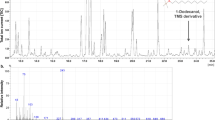Abstract
The dietary effects of the well-known auxin member plant growth regulator, indole-3-acetic acid (IAA), on hemocyte counts and behavior of the model insect Galleria mellonella L. (Lepidoptera: Pyralidae) and its parasitoid Pimpla turionellae L. (Hymenoptera: Ichneumonidae) were examined. In vivo and in vitro experiments involved five treatments applied to larvae with doses of 50, 500, 1000, 5000, and 10000 ppm IAA and the controls. Total hemocyte counts increased at all applied IAA doses in G. mellonella whereas no effect was observed in P. turionellae. According to acridine orange-ethidium bromide double staining, none of the IAA doses affected the ratio of apoptotic and mitotic cells in vivo however a decrease in the number of late apoptotic cells at 1000 and 5000 ppm was observed at in vitro experiments in G. mellonella. An increase in the percentage of early apoptotic hemocytes at 1000 ppm and late apoptotic hemocytes at 500 ppm were determined in P. turionellae larvae. IAA also increased the ratio of mitotic hemocytes in the circulation of P. turionellae larvae at 50, 1000, and 10000 ppm. Changes in the encapsulation rate of Sephadex A-25 beads were not significant however the increase at 5000 ppm at 4th hour in non-melanized hemocytes was recorded as compared to the control. A strong decrease in melanization at 50 ppm and an increase at 50 and 1000 ppm in non-melanized bead count at 24 h were also observed. It can be concluded that IAA is inappropriate to use in combination with microbial control agents in IPM programs due to elevated hemocyte counts of the pest.




Similar content being viewed by others
Data availability
The data and material of this study can be submitted when it is necessary.
References
Abd El-Aziz NM, Awad HH (2010) Changes in the haemocytes of Agrotisipsilon larvae (Lapidoptera: Noctuidae) in relation to dimilin and Bacillus thuringiensis infections. Micron 41:203–209
Abdellaoui K, Halima-Kamel MB, Soltani N, Aribi N, Hamouda MHB (2013) Biochemical and histological effects of gibberellic acid on Locusta migratoria fifth instar larvae. Pestic Biochem Phys 107(1):32–37
Altuntaş H, Kılıç AY, Uçkan F, Ergin E (2012) Effects of Gibberellic Acid on Hemocytes of Galleria mellonella L. (Lepidoptera: Pyralidae). Environ Entomol 41:688–696
Altuntaş H, Uçkan F, Kılıç AY, Ergin E (2014) Effects of gibberellic acid on hemolymph free amino acids of Galleria mellonella (Lepidoptera:Pyralidae) and endoparasitoid Pimpla turionellae (Hymenoptera: Ichneumonidae). Ann Entomol Soc Am 107(5):1000–1009
Blythe EK, Sibley JL, Tilt KM, Ruter JM (2007) Methods of auxin application in cutting propagation: Areview of 70 years of scientific discovery and commercial practice. J Environ Hortic 25(3):166–185
Bogdan C, Rollinghoff M, Diefenbach A (2000) Reactive oxygen and reactive nitrogen intermediates in innate and specific immunity. Curr Opin Immunol 12:64–76 ()
Bronskill JF (1961) A cagetosimplifytherearing of thegreaterwaxmoth, Galleriamellonella (Pyralidae). J Lepid Soc 15:102–104
Brzozowski L, Mazourek M (2018) A sustainable agricultural future relies on the transition to organic agroecological pest management. Sustainability 10:2023
Çelik D, Özbek R, Uçkan F (2017) Effects of Indole-3-Acetic Acid on Hemocytes of Achoria grisella Fabr. (Lepidoptera: Pyralidae). J Entomol Res Soc 19(2):83–93
Cox C (1996) Insecticide Factsheet Cypermethrin. J Pestc Ref 16:15–20
Er A, Keskin M (2016) Influence of abscisic acid on the biology and hemocytes of the model insect Galleria mellonella (Lepidoptera:Pyralidae). Ann Entomol Soc Am 109(2):244–251
Er A, Uçkan F, Rivers DB, Ergin E, Sak O (2010) Effects of Parasitization and Envenomation by the Endoparasitic Wasp Pimpla turionellae (Hymenoptera: Ichneumonidae) on Hemocyte Numbers, Morphology, and Viability of Its Host Galleria mellonella (Lepidoptera:Pyralidae). Ann Entomol Soc Am 103:273–282
Er A, Uçkan F, Rivers DB, Sak O (2011) Cytotoxic effects of parasitism and application of venom from the endoparasitoid Pimpla turionellae on hemocytes of the host Galleria mellonella. J Appl Entomol 135:225–236
Er A, Taşkıran D, Sak O (2017) Azadirachtin induced effects on various life history traits and cellular immune reactions of Galleria mellonella (Lepidoptera:Pyralidae). Arch Biol Sci 69(2):335–344
Fenemore PG (1984) Plant pests and their control. Butterworth-Heinemann, London
Frankenberger WT, Arshad M (1995) Phytohormones in Soils. Marcel Dekker Inc., New York
Fraser SEM, Dytham C, Mayhew PJ, Mouillot D, Anderson BJ (2008) Community structure in ichneumonid parasitoids at different spatial scales. Oecologia. https://doi.org/10.1007/s00442-008-1090-2
Furukawa S, Abe M, Usuda K, Ogawa I (2004) Indole-3-acetic acid induces microencephaly in rat fetuses. Toxicol Pathol 32:659–667
Furukawa S, Usuda K, Abe M, Hayashi S, Ogawa I (2007) Indole-3-acetic acid induces microencephaly in mouse fetuses. Exp Toxicol Pathol 59(1):43–52
Gardiner EMM, Strand MR (2000) Hematopoiesis in larval Pseudoplusia includens and Spodoptera frugiperda. Arch Insect Biochem 43:147–164
Gillespie JP, Kanost MR, Trenczek T (1997) Biological mediators of insect immunity. Annu Rev Entomol 42:611–643
Greathead DJ, Waage JK (1983) Opportunities for biological control of agricultural pests in developing countries. In: World Bank Technical Paper Number 11. The World Bank, Washington
Gupta G, Yadav SR, Bhattacharya AK (2009) Influence of synthetic plant growth substances on the survivorship and developmental parameters of Spilarctia obliqua Walker (Lepidoptera: Arctiidae). J Pestic Sci 82:41–46
Harris MK (1983) Integrated pest management of pecans. Annu Rev Entomol 28:291
James RR, Xu J (2012) Mechanisms by which pesticides affect insect immunity. J Invertebr Pathol 109:175–182
Jiravanichpaisal P, Lee B, Soderhall K (2006) Cell-mediated immunity in arthropods: Hematopoiesis, coagulation, melanization and opsonization. Immunobiology 211:213–236
John JA, Blogg CD, Murray FJ, Schwetz BA, Gehring PJ (1979) Teratogenic effects of the plant hormone indole-3-acetic acid in mice and rats. Teratology 19:321–326
Kaur R, Rup PJ (2002) Evaluation of regulatory influence of four plant growth regulators on the reproductive potential and longevity of melon fruit fly (Bactrocera cucurbitae). Phytoparasitica 30:224–230
Kefford BJ, Zalizniak L, Warne MSJ, Nugegoda D (2008) Is the integration of hormesis and essentiality into ecotoxicology now opening Pandora’s box? Environ Pollut 151:516–523
Kim GS, Kim Y (2010) Up-regulation of circulating hemocyte population in response to bacterial challenge is mediated by octopamine and 5-hydroxytryptamine via Rac1 signal in Spodoptera exigua. J Insect Physiol 56:559–566
Kosmider B, Zyner E, Osiecka R, Ochocki J (2004) Induction of apoptosis and necrosis in A549 cells by the cis-Pt(II) complex of 3-aminoflavone in comparison with cis-DDP. Mutat Res 563:61–70
Lavine MD, Strand MR (2002) Insect hemocytes and their role in immunity. Insect Biochem Mol Biol 32:1295–1309
Lins PG, Valle CR, Pugine SMP, Oliveira DL, Ferreira MSL, Costa EJX, De Melo MP (2006) Effect of indole acetic acid administration on the neutrophil functions and oxidative stress from neutrophil, mesenteric lymph node and liver. Life Sci 78(6):564–570
Lowenberger C (2001) Innate immune response of Aedesaegypti. Insect Biochem Mol Biol 31:219–229
Lukowski A, Janek W, Baraniak E, Walczak U, Karolewski P (2019) Changing host plants causes structural differences in the parasitoid complex of the monophagous moth Yponomeuta evonymella, but does not improve survival rate. Insects 10:197
Marmaras JV, Lampropoulou M (2009) Regulators and signalling in insect haemocyte immunity. Cell Signal 21:186–195
Meister M, Hetru C, Hoffmann JA (2000) The antimicrobial host defense of Drosophila. In: Du Pasquier L, Litman GW (eds) Origin and evolution of the vertebrate immune system, current topics in microbiology. Springer-Verlag, Berlin, pp 17–36
Mowlds P, Barron A, Kavanagh K (2008) Physical stress primes the immune response of Galleria mellonella larvae to infection by Candida albicans. Microb Infect 10:628–634
Muta T, Iwanaga S (1996) The role of hemolympyh coagulation in innate immunity. Curr Opin Immunol 8:41–47
Norayanan K (2004) Insect defense: its impact on microbial control of insect pests. Curr Sci 86:800–813
Oguh CE, Okpaka CO, Ubani CS, Okekeaji U, Joseph PS, Amadi EU (2019) Natural pesticides (biopesticides) and uses in pest management-A critical review. AJBGE 2(3):1–18
Oliveira CM, Auad AM, Mendes SM, Frizzas MR (2014) Crop losses and the economic impact of insect pests on Brazilian agriculture. Crop Prot 56:50–54
Özmen M, Topçuoğlu ŞF, Bozcuk S, Bozcuk NA (1995) Effects of Abscisic Acid and Gibberellic Acid on Sexual Differentiation and Some Physiological Parameters of Laboratory Mice. Turk J Biol 19:357–364
Paulson GS, Hull LA, Biddinger DJ (2005) Effect of a plant growth regulator prohexadione-calcium on insect pests of apple and pear. J Econ Entomol 98:423–431
Pech LL, Strand MR (1996) Granular cells are required for encapsulation of foreign targets by insect haemocytes. J Cell Sci 109:2053–2060
Prado SG, Frank SD (2013) Tritrophic effects of plant growth regulators in an aphid-parasitoid system. Biol Control 66:72–76
Pretty J, Bharucha ZP (2015) Integrated pest management for sustainable intensification of agriculture in Asia and Africa. Insects 6:152–182
Richards EH, Dani MP (2008) Biochemical isolation of an insect haemocyte anti-aggregation protein from the venom of the endoparasitic wasp, Pimpla hypochondriaca, and identification of its gene. J Insect Physiol 54:1041–1049
Richards EH, Edwards JP (2002) Parasitism of Lacanobia oleracea (Lepidoptera) by the Ectoparasitic wasp, Eulophus pennicornis, disrupts the cytoskeleton of host haemocytes and suppresses encapsulation in vivo. Arch Insect Biochem Phys 49(2):108-108 24
Rowley AF, Ratcliffe NA (1981) Insects. In: Ratcliffe NA, Rowley AF (eds) Invertebrate Blood Cells. Academic, London, pp 421–488
Sak O, Uçkan F, Ergin E (2006) Effects of cypermethrin on total body weight, glycogen, protein, and lipid contents of Pimpla turionellae (L.) (Hymenoptera: Ichneumonidae). Belg J Zool 136:53–58
Silva MTB, Costa EC, Boss A (2003) Control of Anticarsia gemmatalis Hubner (Lepidoptera: Noctuidae) larvae with insect growth regulators. Ciênc Rural 33:601–605
Strand MR (2008) The insect cellular immune response. Insect Sci 15:1–14
Strand MR, Pech LL (1995) Immunological basis for compatibility in parasitoid–host relationships. Annu Rev Entomol 40:31–56
Tojo S, Naganuma F, Arakawa K, Yokoo S (2000) Involvement of both granular cells and plasmatocytes in phagocytic reactions in the greater wax moth, Galleria mellonella. J Insect Physiol 46(7):1129–1135
Uçkan F, Tüven A, Er A, Ergin E (2008) Effects of gibberellic acid on biological parameters of the larval endoparasitoid Apanteles galleriae (Hymenoptera: Braconidae). Ann Entomol Soc Am 101:593–597
Uçkan F, Er A, Ergin E (2010) Levels of encapsulation and melanization in Galleria mellonella (Lepidoptera: Pyralidae) parasitized and envenomated by Pimpla turionellae (Hymenoptera: Ichneumonidae). J Appl Entomol 134:718–726
Uçkan F, Haftacı İ, Ergin E (2011) Effects of indol-3-acetic acid on biological parameters of the larval Endoparasitoid Apanteles galleriae (Hymenoptera: Braconidae). Ann Entomol Soc Am 104:77–82
Uçkan F, Soydabaş HK, Özbek R (2014) Effect Of Indol-3 Acetic Acid On The Biochemical Parameters Of Achoria grisella Hemolymph and Apanteles galleriae Larva. Pak J Biotechnol 11(2):163–171
Uçkan F, Özbek R, Ergin E (2015) Effects of Indol-3-Acetic Acid on the biology of Galleria mellonella and its endoparasitoid Pimpla turionellae. Belg J Zool 145(1):49–58
Vass E, Nappi AJ (2001) Fruit fly immunity. BioEssays 51:529–535
Velcheva N, Atanassov A (2016) Species diversity of parasitods reared from codling moth, Cydia pomonella (Linnaeus, 1758) and plum fruit moth, Grapholita funebrana (Treitschke, 1835) (Lepidoptera, Tortricidae) in Bulgaria. Bulg J Agric Sci 22:272–277
Vilmos P, Kurucz É (1998) Insect immunity: evolutionary roots of the mammalian innate immune system. Immunol Lett 62:59–66
Wäckers FL, Björnsen A, Dorn S (1996) A comparison of flowering herbs with respect to their nectar accessibility for the parasitoid Pimpla turionellae. Exp Appl Entomol 7:177–182
Wittmer IK, Scheidegger R, Bader HP, Singer H, Stamm C (2010) Lossrates of urban biocides can exceed those of agricultural pesticides. Scı Total Envıron 409:920–932
Wojda I (2017) Immunity of the greater wax moth Galleria mellonella. Insect Sci 24:342–357
Wu G, Liua Y, Ding Y, Yi Y (2016) Ultrastructural and functional characterization of circulating hemocytes from Galleria mellonella larva: Cell types and their role in the innate immunity. Tissue Cell 48:297–304
Yeşilada E (2000) The Effect of Kinetin, Gibberellic Acid and Indole Acetic Acid on EMS-Induced Somatic Mutation and Recombination in Drosophila melanogaster. Turk J Biol 24:279–284
Yılmaz HR, Yüksel E (2005) İndol-3-asetik asit’in üçüncü nesil farelerin kemik iliği hücrelerinde mitotic indeks üzerine etkileri. SDÜ Tıp Fak Derg 12:46–49
Zhao H, Cao HH, Pan MZ, Sun YX, Liu TX (2017) The role of plant growth regulators in a plant–aphid–parasitoid tritrophic system. J Plant Growth Regul. https://doi.org/10.1007/s00344-017-9689-3
Zibaee A, Bandani AR (2010) Effects of Artemisia annua L. (Asteracea) on the digestive enzymatic profiles and the cellular immune reactions of the Sunn pest, Eurygaster integriceps (Heteroptera: Scutellaridae), against Beauveri abassiana. Bull Entomol Res 100:185–196
Zivkovic IP, Baric B (2012) New records of Pimpla turionellae (Hymenoptera: Ichneumonidae) in Croatia. Entomol Croat 16(1–4):37–40
Acknowledgements
This study was supported by the Scientific Research Coordination Unit of Kocaeli University, Project number: 2012/25.
Funding
This study was supported by the Scientific Research Coordination Unit of Kocaeli University, Project number: 2012/25
Author information
Authors and Affiliations
Corresponding author
Ethics declarations
Conflicts of interest
The authors declare that they have no conflict of interest.
Ethics approval
Not applicable.
Consent to participate
All of the authors accepted to participate in this study.
Consent for publication
All of the authors accepted to publishing of this study in this Journal.
Code availability
Not applicable.
Rights and permissions
About this article
Cite this article
Kaya, S., Uçkan, F. & Er, A. Influence of Indole-3-Acetic Acid on Cellular Immune Responses of Galleria mellonella L. (Lepidoptera: Pyralidae) and Pimpla turionellae L. (Hymenoptera: Ichneumonidae) in a host-parasitoid system. Int J Trop Insect Sci 41, 169–179 (2021). https://doi.org/10.1007/s42690-020-00190-z
Received:
Accepted:
Published:
Issue Date:
DOI: https://doi.org/10.1007/s42690-020-00190-z




